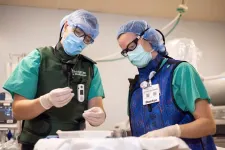(Press-News.org) We humans excel at generalization. If you taught a toddler to identify the color red by showing her a red ball, a red truck and a red rose, she will most likely correctly identify the color of a tomato, even if it is the first time she sees one.
An important milestone in learning to generalize is compositionality: the ability to compose and decompose a whole into reusable parts, like the redness of an object. How we get this ability is a key question in developmental neuroscience – and in AI research.
The earliest neural networks, which have later evolved into the large language models (LLMs) revolutionizing our society, were developed to study how information is processed in our brains. Ironically, as these models became more sophisticated, the information processing pathways within also became increasingly opaque, with some models today having trillions of tunable parameters.
But now, members of the Cognitive Neurorobotics Research Unit at the Okinawa Institute of Science and Technology (OIST) have created an embodied intelligence model with a novel architecture that allows researchers access to the various internal states of the neural network, and which appears to learn how to generalize in the same ways that children do. Their findings have now been published in Science Robotics. “This paper demonstrates a possible mechanism for neural networks to achieve compositionality,” says Dr. Prasanna Vijayaraghavan, first author of the study. “Our model achieves this not by inference based on vast datasets, but by combining language with vision, proprioception, working memory, and attention – just like toddlers do.”
Perfectly imperfect
LLMs, founded on a transformer network architecture, learn the statistical relationship between words that appear in sentences from vast amounts of text data. They essentially have access to every word in every conceivable context, and from this understanding, they predict the most probable answer to a given prompt. By contrast, the new model is based on a PV-RNN (Predictive coding inspired, Variational Recurrent Neural Network) framework, trained through embodied interactions integrating three simultaneous inputs related to different senses: vision, with a video of a robot arm moving colored blocks; proprioception, the sense of our limbs’ movement, with the joint angles of the robot arm as it moves; and a language instruction like “put red on blue.” The model is then tasked to generate either a visual prediction and corresponding joint angles in response to a language instruction, or a language instruction in response to sensory input.
The system is inspired by the Free Energy Principle, which suggests that our brain continuously predicts sensory inputs based on past experiences and takes action to minimize the difference between prediction and observation. This difference, quantified as ‘free energy’, is a measure of uncertainty, and by minimizing free energy, our brain maintains a stable state. Together with limited working memory and attention span, the AI mirrors human cognitive constraints, forcing it to process input and update its prediction in sequence rather than all at once like LLMs do. By studying the flow of information within the model, researchers can gain insights into how it integrates the various inputs to generate its simulated actions.
It is thanks to this modular architecture that the researchers have learned more about how infants may develop compositionality. As Dr. Vijayaraghavan recounts, “We found that the more exposure the model has to the same word in different contexts, the better it learns that word. This mirrors real life, where a toddler will learn the concept of the color red much faster if she’s interacted with various red objects in different ways, rather than just pushing a red truck on multiple occasions.”
Opening the black box
“Our model requires a significantly smaller training set and much less computing power to achieve compositionality. It does make more mistakes than LLMs do, but it makes mistakes that are similar to how humans make mistakes,” says Dr. Vijayaraghavan. It is exactly this feature that makes the model so useful to cognitive scientists, as well as to AI researchers trying to map the decision-making processes of their models. While it serves a different purpose than the LLMs currently in use, and therefore cannot be meaningfully compared on effectiveness, the PV-RNN nevertheless shows how neural networks can be organized to offer greater insight into their information processing pathways: its relatively shallow architecture allows researchers to visualize the network's latent state – the evolving internal representation of the information retained from the past and used in present predictions.
The model also addresses the Poverty of Stimulus problem, which posits that the linguistic input available to children is insufficient to explain their rapid language acquisition. Despite having a very limited dataset, especially compared to LLMs, the model still achieves compositionality, suggesting that grounding language in behavior may be an important catalyst for the impressive language learning ability of children.
This embodied learning could moreover show the way for safer and more ethical AI in the future, both by improving transparency, and by it being able to better understand the effects of its actions. Learning the word ‘suffering’ from a purely linguistic perspective, as LLMs do, would carry less emotional weight than for a PV-RNN, which learns the meaning through embodied experiences together with language.
“We are continuing our work to enhance the capabilities of this model and are using it to explore various domains of developmental neuroscience. We are excited to see what future insights into cognitive development and language learning processes we can uncover,” says Professor Jun Tani, head of the research unit and senior author on the paper. How we acquire the intelligence to create our society is one of the great questions in science. While the PV-RNN hasn’t answered it, it opens new research avenues into how information is processed in our brain. “By observing how the model learns to combine language and action,” summarizes Dr. Vijayaraghavan, “we gain insights into the fundamental processes that underlie human cognition. It has already taught us a lot about compositionality in language acquisition, and it showcases potential for more efficient, transparent, and safe models.”
END
New, embodied AI reveals how robots and toddlers learn to understand
With a brain-inspired architecture, the model offers insights into cognitive development and information processing in neural networks.
2025-01-23
ELSE PRESS RELEASES FROM THIS DATE:
Game, set, match: Exploring the experiences of women coaches in tennis
2025-01-23
Game, set, match: Exploring the experiences of women coaches in tennis
As the Australian Open continues in full swing, a new study can reveal female tennis coaches experience significantly more barriers in their profession – including discrimination and marginalisation – than their male counterparts, with fewer than half seeing themselves continuing as coaches long term.
Led by Dr Jasmine Petersen from Flinders University’s Caring Futures Institute, the study interviewed 243 Australian tennis coaches, a third of which were women, assessing their motivation and barriers towards coaching and the support they received.
“Women coaches continue ...
Significant rise in mental health admissions for young people in last decade
2025-01-23
There was a 65% increase in the number of children and young people being admitted to general acute medical wards in hospitals in England because of a mental health concern between 2012 and 2022, finds a new study led by UCL researchers.
The study, published in The Lancet Child and Adolescent Health journal and funded by the National Institute for Health and Care Research (NIHR) and the NIHR Great Ormond Street Hospital Biomedical Research Centre (NIHR GOSH BRC), analysed data on all admissions of five- to 18-year-olds to medical wards in England from April 1st 2012 to March 31st 2022.
General acute medical wards are specialised hospital wards designed to provide rapid ...
Prehab shows promise in improving health, reducing complications after surgery
2025-01-23
A new study published in The BMJ suggests that prehabilitation (also called prehab) may be able to reduce complications and length of hospitalization after surgery, while also improving quality of life and physical recovery. The systematic review and meta-analysis, which is the largest of its kind, examined data from more than 15,000 patients who participated in 186 randomized controlled clinical trials around the world.
The researchers looked at various kinds of prehab, including exercise, nutritional enhancement, psychological support, cognitive ...
Exercise and improved diet before surgery linked to fewer complications and enhanced recovery
2025-01-23
Actively preparing for major surgery by exercising and improving diet (known as “prehabilitation”) is associated with fewer complications, less time in hospital, and improved recovery and quality of life in adults, finds an analysis of clinical trials published by The BMJ today.
The researchers stress that the certainty of evidence for all comparisons was generally low to very low, but they say prehabilitation based on exercise, nutrition, or exercise combined with other components, may be beneficial.
Existing evidence suggests that prehabilitation can improve outcomes after surgery, but there’s a lack of clarity about which components, ...
SGLT-2 drug plus moderate calorie restriction achieves higher diabetes remission
2025-01-23
Adults with overweight or obesity and type 2 diabetes who are given the sodium glucose cotransporter 2 (SGLT-2) inhibitor drug dapagliflozin alongside moderate calorie restriction achieve much higher rates of remission compared with calorie restriction alone, finds a trial published by The BMJ today.
The researchers say this study provides a practical strategy to achieve remission for patients with early type 2 diabetes.
Type 2 diabetes affects over 400 million adults worldwide. It’s not necessarily a permanent condition and can be reversed by intensive weight management, ...
Could the Summerville ghost lantern be an earthquake light?
2025-01-23
Gather around, and let Susan Hough tell you the tale of the Summerville Light.
Legend has it that the strange orb sometimes seen hovering over the railroad tracks in the remote area around Summerville, South Carolina is a lantern borne by a ghost whose husband lost his head in a train accident.
But Hough, a seismologist at the U.S. Geological Survey, wonders if there might be a less ethereal but no less intriguing possibility: is the source of the Summerville Light a phenomenon known as earthquake ...
Will the U.S. have enough pain specialists?
2025-01-22
(SACRAMENTO) — Nearly a quarter of adults in the U.S. have chronic pain, but a new study from the UC Davis School of Medicine shows a concerning drop in residents applying to pain medicine fellowship programs.
The study was published in PAIN Practice. It found the number of anesthesiology residents applying for pain medicine fellowships — historically the key pool of applicants — dropped 45% between 2019 and 2023.
“While the demand for pain specialists is growing in the U.S., the pipeline of new doctors to fill these roles is drying up,” said Scott Pritzlaff, the study’s ...
Stronger stress response in monkeys helps them survive
2025-01-22
Key takeaways
The team used the environmental circumstances and fecal samples collected from the six years prior to the El Niño drought to study the relationship between the endocrinologic stress response and survival in the white-faced capuchins.
Monkeys who showed a steeper rise in these stress hormones during the mild droughts were more likely to survive the severe El Niño drought.
As weather intensifies globally, longitudinal studies of how wild animals cope with changes in temperature, rainfall and food availability can help us understand which species ...
Using infrared heat transfer to modify chemical reactions
2025-01-22
In a joint experimental-theoretical work, a team of researchers, including theorists from UC San Diego, have shown for the first time that heat transfer in the form of infrared radiation can influence chemical reactions more strongly than traditional convection and conduction methods.
Using an optical cavity to confine infrared light waves, researchers focused on the thermal dehydration of an inorganic crystal, copper sulfate pentahydrate. They found that light-matter vibrational coupling (resulting in states known as polaritons) lowered ...
Being a ladies' man comes at a price for alpha male baboons
2025-01-22
DURHAM, N.C. -- A few things come to mind when we imagine the “alpha male” type. They’re the ones calling the shots, who get all the girls. But there’s a downside to being a strong and powerful alpha stud -- at least if you’re a baboon.
Studies show that despite their high rank, the No. 1 males in baboon society are also some of the most stressed out, as measured by their high levels of glucocorticoids, the hormones involved in the ‘fight-or-flight’ response.
But the leaders’ stress burden comes from a surprising source. New research reveals ...
LAST 30 PRESS RELEASES:
Cuffless blood pressure technologies in wearable devices show promise to transform care
AI-based tool predicts future cardiovascular events in patients with angina
Researchers map how the cerebellum builds its connections with the rest of the brain during early development
Routine scans could detect early prostate radiotherapy changes
Fairness in AI: Study shows central role of human decision-making
Pandemic ‘beneath the surface’ has been quietly wiping out sea urchins around the world
Tea linked to stronger bones in older women, while coffee may pose risks
School feeding programs lead to modest but meaningful results
Researchers develop AI Tool to identify undiagnosed Alzheimer's cases while reducing disparities
Seaweed based carbon catalyst offers metal free solution for removing antibiotics from water
Simple organic additive supercharges UV treatment of “forever chemical” PFOA
£13m NHS bill for ‘mismanagement’ of menstrual bleeds
The Lancet Psychiatry: Slow tapering plus therapy most effective strategy for stopping antidepressants, finds major meta-analysis
Body image issues in adolescence linked to depression in adulthood
Child sexual exploitation and abuse online surges amid rapid tech change; new tool for preventing abuse unveiled for path forward
Dragon-slaying saints performed green-fingered medieval miracles, new study reveals
New research identifies shared genetic factors between addiction and educational attainment
Epilepsy can lead to earlier deaths in people with intellectual disabilities, study shows
Global study suggests the underlying problems of ECT patients are often ignored
Mapping ‘dark’ regions of the genome illuminates how cells respond to their environment
ECOG-ACRIN and Caris Life Sciences unveil first findings from a multi-year collaboration to advance AI-powered multimodal tools for breast cancer recurrence risk stratification
Satellite data helps UNM researchers map massive rupture of 2025 Myanmar earthquake
Twisting Spins: Florida State University researchers explore chemical boundaries to create new magnetic material
Mayo Clinic researchers find new hope for toughest myeloma through off-the-shelf immunotherapy
Cell-free DNA Could Detect Adverse Events from Immunotherapy
American College of Cardiology announces Fuster Prevention Forum
AAN issues new guideline for the management of functional seizures
Could GLP-1 drugs affect risk of epilepsy for people with diabetes?
New circoviruses discovered in pilot whales and orcas from the North Atlantic
Study finds increase in risk of binge drinking among 12th graders who use 2 or more cannabis products
[Press-News.org] New, embodied AI reveals how robots and toddlers learn to understandWith a brain-inspired architecture, the model offers insights into cognitive development and information processing in neural networks.


